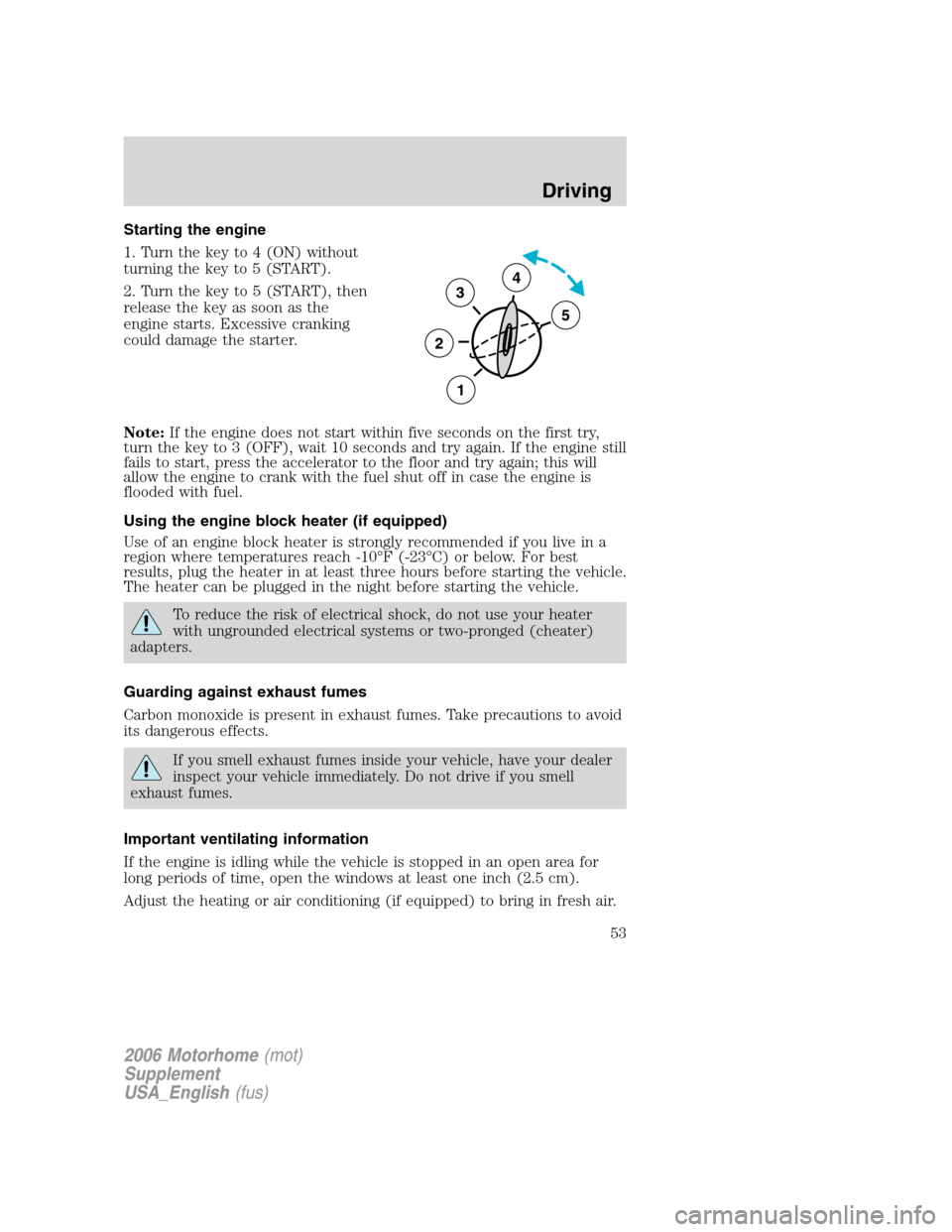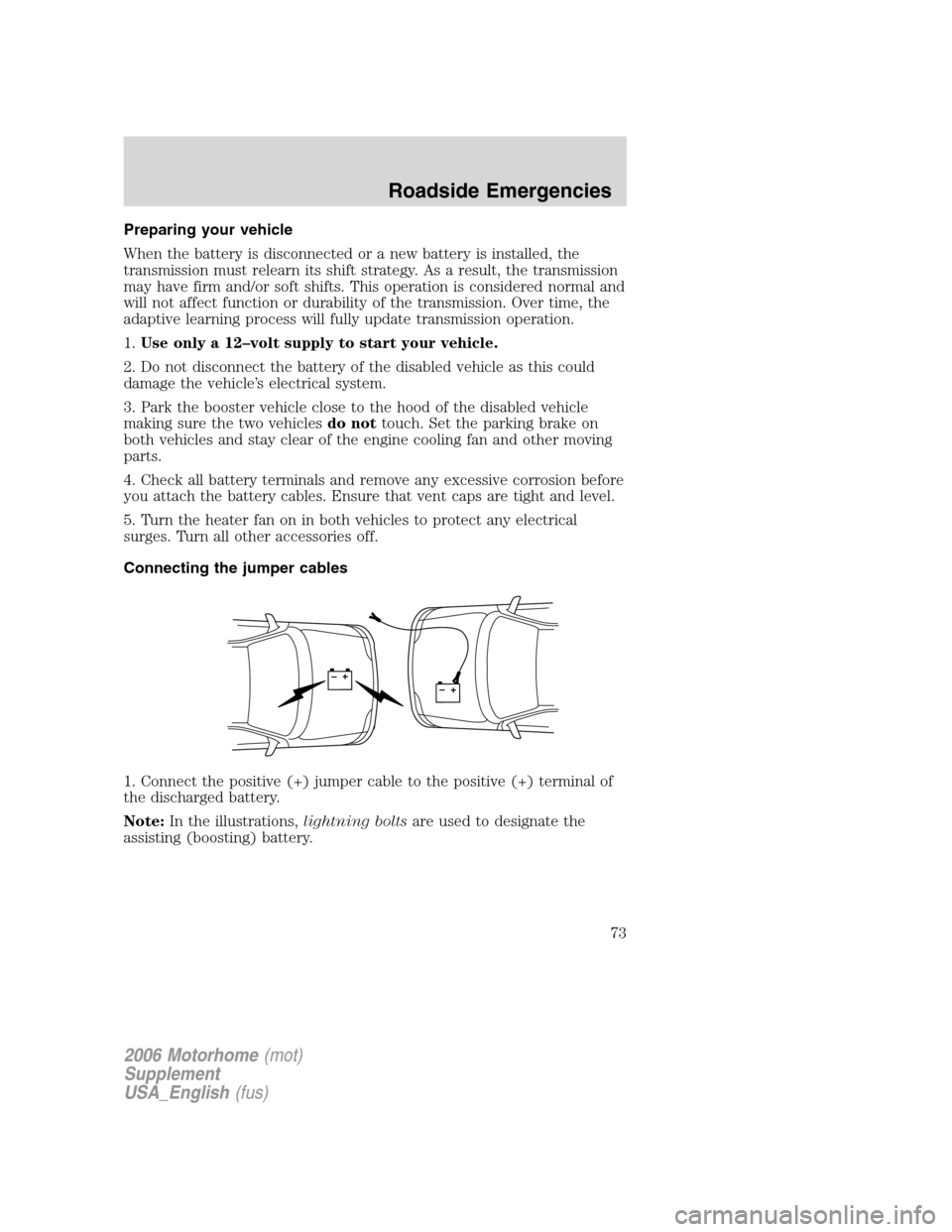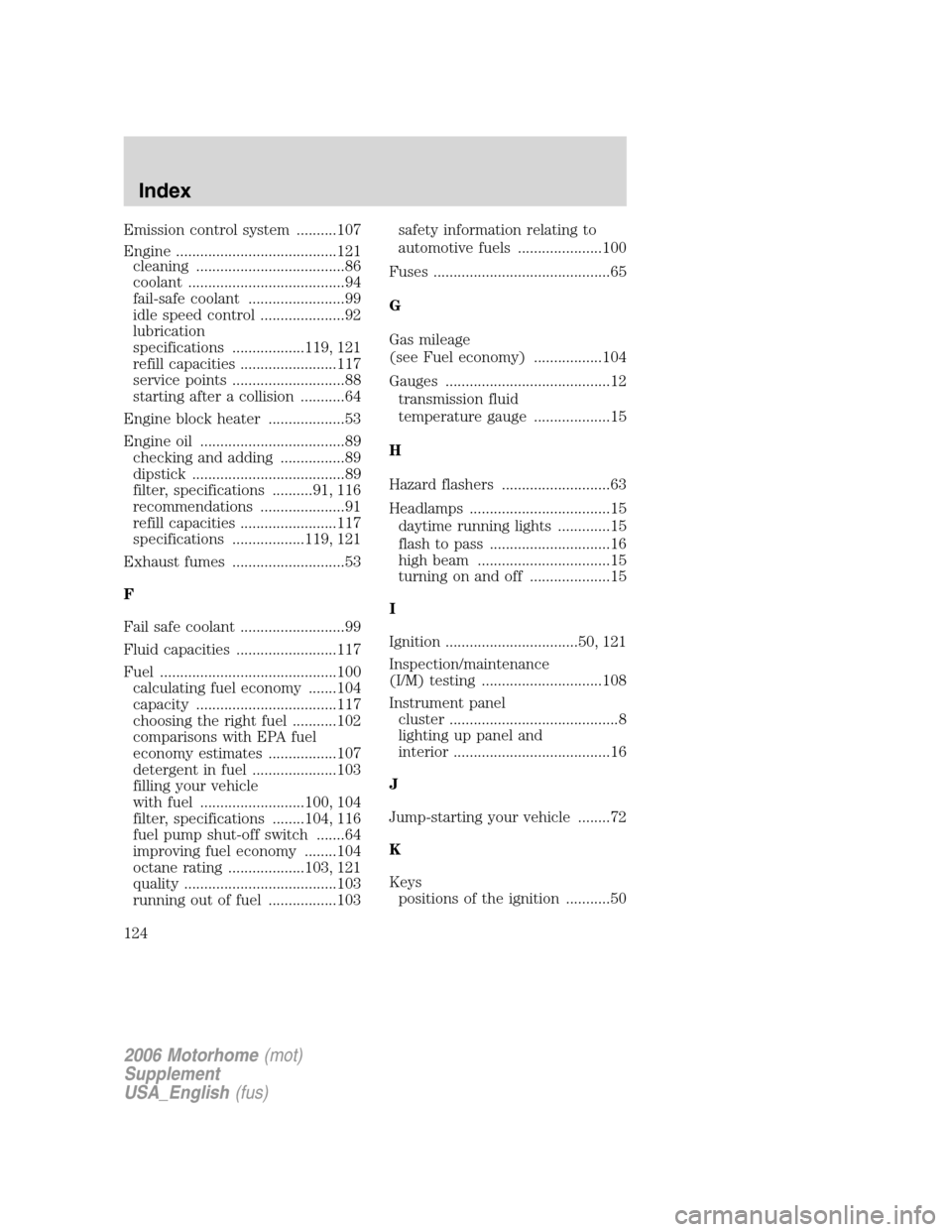heater FORD F SERIES MOTORHOME AND COMMERCIAL CHASSIS 2006 11.G Owners Manual
[x] Cancel search | Manufacturer: FORD, Model Year: 2006, Model line: F SERIES MOTORHOME AND COMMERCIAL CHASSIS, Model: FORD F SERIES MOTORHOME AND COMMERCIAL CHASSIS 2006 11.GPages: 128, PDF Size: 1.14 MB
Page 53 of 128

Starting the engine
1. Turn the key to 4 (ON) without
turning the key to 5 (START).
2. Turn the key to 5 (START), then
release the key as soon as the
engine starts. Excessive cranking
could damage the starter.
Note:If the engine does not start within five seconds on the first try,
turn the key to 3 (OFF), wait 10 seconds and try again. If the engine still
fails to start, press the accelerator to the floor and try again; this will
allow the engine to crank with the fuel shut off in case the engine is
flooded with fuel.
Using the engine block heater (if equipped)
Use of an engine block heater is strongly recommended if you live in a
region where temperatures reach -10°F (-23°C) or below. For best
results, plug the heater in at least three hours before starting the vehicle.
The heater can be plugged in the night before starting the vehicle.
To reduce the risk of electrical shock, do not use your heater
with ungrounded electrical systems or two-pronged (cheater)
adapters.
Guarding against exhaust fumes
Carbon monoxide is present in exhaust fumes. Take precautions to avoid
its dangerous effects.
If you smell exhaust fumes inside your vehicle, have your dealer
inspect your vehicle immediately. Do not drive if you smell
exhaust fumes.
Important ventilating information
If the engine is idling while the vehicle is stopped in an open area for
long periods of time, open the windows at least one inch (2.5 cm).
Adjust the heating or air conditioning (if equipped) to bring in fresh air.
3
2
1
5
4
2006 Motorhome(mot)
Supplement
USA_English(fus)
Driving
53
Page 73 of 128

Preparing your vehicle
When the battery is disconnected or a new battery is installed, the
transmission must relearn its shift strategy. As a result, the transmission
may have firm and/or soft shifts. This operation is considered normal and
will not affect function or durability of the transmission. Over time, the
adaptive learning process will fully update transmission operation.
1.Use only a 12–volt supply to start your vehicle.
2. Do not disconnect the battery of the disabled vehicle as this could
damage the vehicle’s electrical system.
3. Park the booster vehicle close to the hood of the disabled vehicle
making sure the two vehiclesdo nottouch. Set the parking brake on
both vehicles and stay clear of the engine cooling fan and other moving
parts.
4. Check all battery terminals and remove any excessive corrosion before
you attach the battery cables. Ensure that vent caps are tight and level.
5. Turn the heater fan on in both vehicles to protect any electrical
surges. Turn all other accessories off.
Connecting the jumper cables
1. Connect the positive (+) jumper cable to the positive (+) terminal of
the discharged battery.
Note:In the illustrations,lightning boltsare used to designate the
assisting (boosting) battery.
+–+–
2006 Motorhome(mot)
Supplement
USA_English(fus)
Roadside Emergencies
73
Page 124 of 128

Emission control system ..........107
Engine ........................................121
cleaning .....................................86
coolant .......................................94
fail-safe coolant ........................99
idle speed control .....................92
lubrication
specifications ..................119, 121
refill capacities ........................117
service points ............................88
starting after a collision ...........64
Engine block heater ...................53
Engine oil ....................................89
checking and adding ................89
dipstick ......................................89
filter, specifications ..........91, 116
recommendations .....................91
refill capacities ........................117
specifications ..................119, 121
Exhaust fumes ............................53
F
Fail safe coolant ..........................99
Fluid capacities .........................117
Fuel ............................................100
calculating fuel economy .......104
capacity ...................................117
choosing the right fuel ...........102
comparisons with EPA fuel
economy estimates .................107
detergent in fuel .....................103
filling your vehicle
with fuel ..........................100, 104
filter, specifications ........104, 116
fuel pump shut-off switch .......64
improving fuel economy ........104
octane rating ...................103, 121
quality ......................................103
running out of fuel .................103safety information relating to
automotive fuels .....................100
Fuses ............................................65
G
Gas mileage
(see Fuel economy) .................104
Gauges .........................................12
transmission fluid
temperature gauge ...................15
H
Hazard flashers ...........................63
Headlamps ...................................15
daytime running lights .............15
flash to pass ..............................16
high beam .................................15
turning on and off ....................15
I
Ignition .................................50, 121
Inspection/maintenance
(I/M) testing ..............................108
Instrument panel
cluster ..........................................8
lighting up panel and
interior .......................................16
J
Jump-starting your vehicle ........72
K
Keys
positions of the ignition ...........50
2006 Motorhome(mot)
Supplement
USA_English(fus)
Index
124